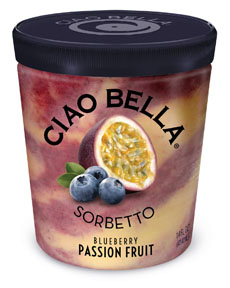PRODUCT: Ciao Bella Gelato & Sorbetto
 Blueberry and passion fruit unite in swirls of sorbetto. Photo courtesy Ciao Bella. |
Ciao Bella, maker of premium gelato and sorbetto, recently introduced two new flavors, and sent us samples. We’re longtime fans of Ciao Bella. Before they hit the big time, they were a destination scoop shop in our town—way back in 1983.
So we weren’t surprised at how much we liked the new varieties, both comprising two swirled flavors: We love ice cream and gelato* experience made us realize how truly wonderful a finet sorbet is. The emphasis is on “fine.” |
|
|
Because sorbet made with the best quality fruit can be transformative—the experience of soft, frozen fruit as opposed to a sweet, frozen dessert. While the gelato comforted us with its creaminess, the sorbetto woke our taste buds and made them dance. We felt not only happy, but lucky to be tasting such a wonderful incarnation of blueberries and passion fruit. |
||
|
WHAT IS MASCARPONE
Mascarpone is often refer to as Italian cream cheese; but please, don’t think of this rich, lush, soft fresh cheese as anything resembling a brick of foil-wrapped cheese† filled with gum. Made from cream, not milk, mascarpone is the richest fresh cheese, ranging in butterfat content from 70% to 75%. As points of reference: |
 A dish of creamy mascarpone. Photo by Melody Lan | THE NIBBLE. |
|
|
But it can be used in savory recipes as well—pasta sauce, savory tarts/tartlets, stuffed chicken and tortas, among others. Wherever it goes, it adds to the creaminess and richness of the dish without overwhelming the taste. Pronounce It Correctly! Mascarpone may have the distinction of being the most misspelled and mispronounced cheese. Too many Americans call it “marscapone.” The correct pronunciation is mas-car-POH-neh. It is not, let us repeat not, mar-sca-POH-neh. The cheese is believed to have originated in the Lombardy region of Italy, in the late 1500s or early 1600s. Lombardy, in the northern part of the country (it includes the cities of Brescia, Cremona, Mantova, Milano and Sondrio), has a rich agricultural and dairy heritage. The name likely derives from “mascarpia,” the local dialect term for ricotta, because both ricotta and mascarpone are made by very similar processes. Mascarpone could have been a glorious accident in the preparation of ricotta. No cheese starter or rennet is used in its production; the moisture is drained from heavy cream using a small amount of citric acid and finely woven cloth. You can make it at home. Here’s a recipe. †Philadelphia Cream Cheese, for example, consists of milk and cream, whey protein concentrate, salt, carob bean gum, xanthan gum and cheese culture. |
||